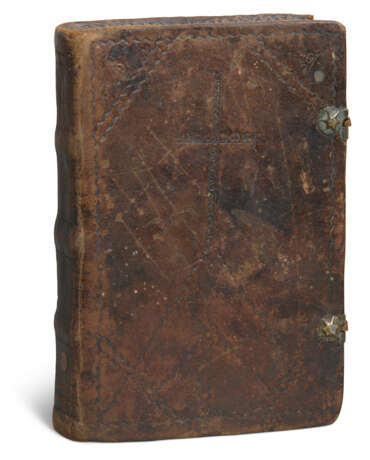ID 1053190
Lot 76 | Late Byzantine notation
Estimate value
£ 3 000 – 5 000
Papadike, in Greek, decorated manuscript on paper [Ottoman Empire, ?Macedonia]
An 18th-century copy of the Papadike, the most concise introduction to the last phase of Byzantine notation.
160 x 110mm. v + 145 leaves, modern pencil foliation, sporadic earlier pagination, 18 lines, text block: c.110 x 75mm, headings, two- to four-line initials and papadic musical signs in red, else written and notated throughout in black ink, decorative headpieces in black and red, half-page diagram of the eight musical modes on f.6v, f.145 written in a later hand (occasional browning and marginal thumbing, else in excellent condition). Original binding of blind-stamped calf over wooden boards, metal clasps.
Provenance:
(1) 19th-century annotations suggest that the manuscript was in use in one of the religious houses in Macedonia: an inscription on f.6v reads ‘Pavougades and Jonas the priest’ [according to the classical scholar Professor Martin Litchfield West (1937-2015)].
(2) Carla Signorini, Venice; according to –
(3) Jeremy Griffiths, Oxford; from whom acquired July 1994.
(4) Schøyen Collection, MS 1897.
Content:
Papadike, a manual of musical instruction, citing works by composers of Greek church music including: Joannes Glykys (fl. late 13th century); Peter Danilo (15th century); Chrisaphos Tuneu (17th century); and Peter the Lampadarios a.k.a. Peter the Peloponnessian (c. 1730-1778). See E. Wellesz, A History of Byzantine Music and Hymnography, 1961, pp.284-7).
| Auction house category: | Letters, documents and manuscripts |
|---|
| Auction house category: | Letters, documents and manuscripts |
|---|
| Address of auction |
CHRISTIE'S 8 King Street, St. James's SW1Y 6QT London United Kingdom | ||||||
|---|---|---|---|---|---|---|---|
| Preview |
| ||||||
| Phone | +44 (0)20 7839 9060 | ||||||
| Buyer Premium | see on Website | ||||||
| Conditions of purchase | Conditions of purchase |






